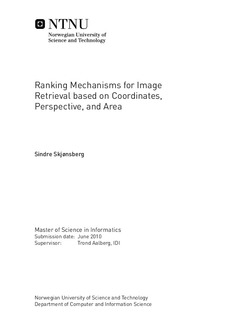| dc.description.abstract | Image retrieval is becoming increasingly relevant as the size of image collections, and amount of image types grow. One of these types is aerial photography, unique in that it can be represented by its spatial content, and through this, be combined with digital maps. Finding good ways of describing this image type with regard to performing queries and ranking results is therefore an important task, and what this study is about.Existing systems already combine maps and imagery, but does not take the spatial features found within each image into consideration. Instead, more traditional external metadata, e.g. file name, author, and date are used when performing retrieval operations on the objects involved.A set of requirements for an image retrieval system on aerial photography using spatial features, were suggested. This described the image- and query types one can expect such a system to handle, and how the information found within these could be represented. A prototype was developed based on these requirements, evaluating the performance of single coordinate queries and a relevance calculation using the coverage, perspective, and areas of interest found in each picture.The prototype evaluation shows that the different characteristics found in aerial photography makes it very difficult to represent and rank all these images in the same way. Especially images taken horizontally, i.e. where the horizon is showing, have other properties than images looking straight down on an area. The evaluation also shows problems related to manual registration of spatial features for images covering large areas, where inaccuracies introduced here can have a damaging effect on ranking.Suggestions for future work with spatial image retrieval are mentioned, proposing alternatives to the spatial features used in the prototype, improvements for calculating relevance, as well as technologies that might help the feature extraction process. | nb_NO |

